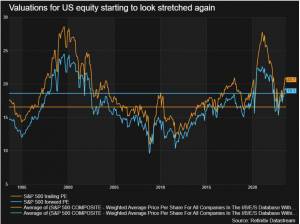The US earnings season is coming to an end. Overall, we can conclude it has been a good one, as 79% of the companies have beaten earnings expectations (93% reported – as of 16 August), above the last 10-year average of 73% (source: Factset). Revenue-beating is, so far, at 63% – exactly the same as the last 10-year average (source: Factset). On aggregate, according to Refinitv, earnings have exceeded estimates by 7.7%, leading so far to a decline in earnings of around 5%.
On the negative side, interestingly, earnings-based price reaction has only been mildly positive (0.4% vs the 1% 5-years average), and, despite the surprises, overall expectations for next quarter growth haven’t basically moved (0.1% up).

Tech and banks
The two most closely monitored sectors this earnings season were finance and tech. The first, to address the impact of the banking crisis and the chances of new incoming issues. The second, to assess the true strength of the AI revolution in the short and medium term and whether that justifies the 30% YTD Nasdaq performance.
Starting in finance, big banks have held up well overall, supported by particularly good numbers from the biggest commercial players. JP Morgan, above all, has beaten estimates, thanks to the benefits of the First Republic deal, with profits surging to a new record and net interest margin up 44% YoY. As for the regional banks, things also look positive overall, even if many institutions reported sharp profits decline (KeyCorp, Western Alliance), and this is mostly thanks to the fact that deposits stayed, at least for the bigger regional banks, more or less stable. In other words, the odds of another bank-run are lower and depositors seem to trust these banks again. The SVB baking crisis can probably be considered resolved once for all.
Looking at tech, the picture is a bit more mixed. On aggregate, from a fundamental perspective, the sector has been the best one (together with healthcare), with 92% of reporting companies beating earnings estimates (82% reported – as of August 16th). However, market reaction has been negative even in case of beaten earnings – with a horrible -2.7% on average in the two days following the calls – highlighting how high valuations are. The AI frenzy has generated a wave of optimism in the sector, making values soar to record levels. Fundamentals will need to beat estimates consistently in the medium term to allow this sector to grow. Crucially, Nvidia, the protagonist in the AI saga, hasn’t reported yet, so it’s impossible to draw any clear conclusions for now.
Key conclusions
Even if the companies are showing good numbers, valuations are high after the YTD rally and expectations need not only to stay strong, but to keep surprising on the upside, together with economic growth, to justify these relative prices.

We think there are still some downside risks to this scenario, particularly due to quantitative tightening and credit tightening, and this is why we maintain a slightly conservative positioning. However, since the beginning of the year, the US economy has systematically surprised on the upside, inflation has fallen more than expected, and companies are, as shown by the earnings season, holding up better than expected. This could continue and the odds of a soft landing are certainly higher than a few months ago.
In the last couple of weeks, the S&P has retraced in quite a punchy way, mostly due to monetary markets starting to trust the Fed more (hence rates going up), but we think we are very close to peak rates now, even for the longer maturities. Going forward then, always assuming inflation won’t pick up unexpectedly (which is not our base case), markets can do well if the benign trend in economic and earnings surprises continue. For now, we stay slightly conservative, but we prepare to act in case the inversion in monetary policy will keep failing to have any significant effect on economic performance.
 Giorgio Broggi: Giorgio joined Moneyfarm as a Quantitative Analyst in December 2021 and he is a member of the Investment Committee. Prior to joining the company, he worked at Barclays Wealth Management and S&P Market Intelligence, gaining expertise in Funds Research and ESG Investing. Before starting his professional life, he successfully completed a double-degree at Eada and EDHEC Business School, obtaining two Masters in Finance and specialising in factor investing and portfolio construction. He is a CFA charterholder.
Giorgio Broggi: Giorgio joined Moneyfarm as a Quantitative Analyst in December 2021 and he is a member of the Investment Committee. Prior to joining the company, he worked at Barclays Wealth Management and S&P Market Intelligence, gaining expertise in Funds Research and ESG Investing. Before starting his professional life, he successfully completed a double-degree at Eada and EDHEC Business School, obtaining two Masters in Finance and specialising in factor investing and portfolio construction. He is a CFA charterholder.
*As with all investing, financial instruments involve inherent risks, including loss of capital, market fluctuations and liquidity risk. Past performance is no guarantee of future results. It is important to consider your risk tolerance and investment objectives before proceeding.





